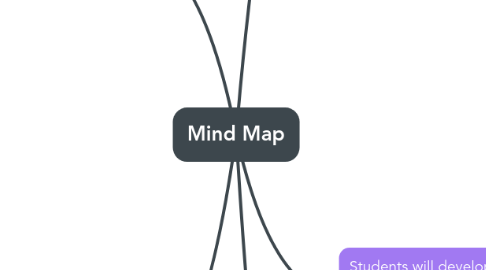
1. Students will use reflective writing to improve their writing.
1.1. Reflect on deliberate choices made in a piece of writing
1.1.1. Writing Exchanges 1-4
1.1.2. Studio 3
1.2. Learn and apply the language of writing studies and rhetoric by employing key words in their reflective writing
1.2.1. Writing Exchange 2
1.2.2. Writing Exchange 3
1.2.3. Writing Exchange 4
1.3. Synthesize and integrate insights from one project into another through reflective learning
1.3.1. Studios 1-4
1.3.2. Writing Exchange 4
1.3.3. Writing Exchange 6
1.4. Reflect on how approaches learned in the course may apply to future writing situations
1.4.1. Writing Exchange 4-6
1.4.2. Studio 1
2. Students will demonstrate the ability to think critically through diverse reading and writing tasks.
2.1. Locate and use a diverse range of digital and print texts as resources for writing
2.1.1. Writing Exchange 6
2.1.2. Studio 4
2.2. Understand the purpose and process of inquiry
2.2.1. Studio 1
2.2.2. Writing Exchange 1-4
2.3. Engage critically with a variety of source material to analyze, synthesize, interpret, and evaluate ideas, information, and texts
2.3.1. All Writing Exchanges
2.3.2. Portfolio
2.3.3. All Studios
3. Students will enact rhetorical choices, moves, and strategies for effective composing in print and online contexts.
3.1. Use research-based views of writing to explain how texts work and what readers and writers are doing
3.1.1. Writing Exchange 2: Permission to Fail
3.1.2. Writing Exchange 3: Writing as Situated
3.1.3. Writing Exchange 4: Genre as Activity
3.1.4. Writing Exchange 7: Process & Revision
3.2. Theorize about the work that language does in the world
3.2.1. Writing Exchange 4: Genre as Activity
3.2.2. Peer Reponse WE2: Permission to Fail
3.3. Demonstrate the ability to meet readers’ expectations by being adaptive, flexible writers
3.3.1. Writing Exchange 2: Permission to Fail
3.3.2. Writing Exchange 1: What is Writing?
3.3.3. All Studios
3.4. Demonstrate the ability to shift voice, tone, formality, design, medium, and layout to achieve a specific purpose
3.4.1. All Studios
3.4.2. Writing Exchange 4: Genre as an Activity
3.4.3. Writing Exchange 3: Writing as a Situated Practice
4. Students will develop the ability to navigate the stages of writing through a variety of composing processes.
4.1. Use multiple strategies to conceptualize, develop, and finalize projects
4.1.1. Portfolio
4.2. Develop composing processes for different tasks and occasions
4.2.1. All Writing Exchanges
4.2.2. All Studios
4.3. Create new composing habits for unfamiliar tasks in both print and multimodal projects
4.3.1. Studio 1-4
4.4. Respond to feedback by instructor and peers for effective revision
4.4.1. Portfolio Assignments
5. Students will identify and navigate new and diverse reading and writing situations and tasks that require their adaptation to shifting expectations and genres.
5.1. Demonstrate understanding that meaning is shaped by readers’ and writers' understanding of context and genre
5.1.1. Writing Exchange 4: Genre as an Activity
5.1.2. Writing Exchange 3: Writing as a Situated Practice
5.2. Analyze how genres are constructed through various discourse communities
5.2.1. Writing Exchanges 2-4
5.2.2. Studio 3
5.3. Apply the tone, style, organization, graphics, and document design that meets the expectations of the genre
5.3.1. Studio 1-4
5.3.2. Writing Exchange 3
5.4. Use citation practices consistent with the genre and demonstrate an understanding of fair-use
5.4.1. All assignments
